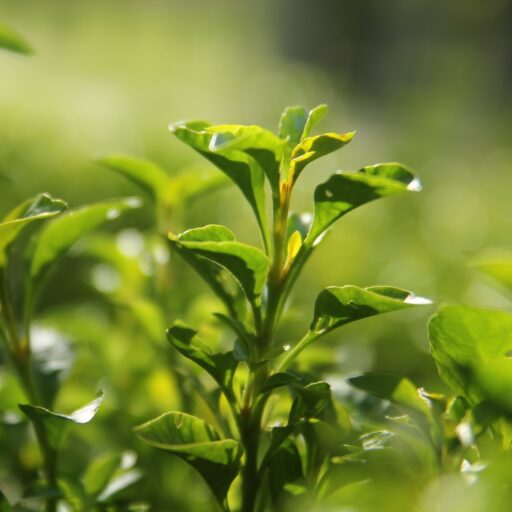Support our educational content for free when you purchase through links on our site. Learn more
How Long Does It Take to Grow a Tea Plant? [2023]
If you’re a tea enthusiast and have ever wondered how long it takes to grow a tea plant, you’ve come to the right place. Our team at Growing Teas™ is here to provide you with all the information you need to know about growing tea plants. From planting to harvesting, we’ll cover every aspect of the tea plant’s growth journey. So grab a cup of your favorite tea and let’s dive in!
Table of Contents
- Quick Answer
- Quick Tips and Facts
- Can You Grow Tea Plants at Home?
- How Do You Plant a Tea Bush?
- What Type of Soil Works Best for Planting Tea?
- How Far Apart Should Plants Be Spaced?
- How Much Light Does a Tea Plant Need?
- How Long Does a Tea Plant Take to Grow?
- How Much Water Does a Tea Plant Need?
- What Are Tea Flowers Used For?
- Where Can I Buy a Tea Plant?
- Conclusion
- Recommended Links
- Reference Links
Quick Answer
Growing a tea plant, also known as Camellia sinensis, requires patience and care. On average, it takes about 3 to 5 years for a tea plant to reach maturity and be ready for harvesting. However, this timeline can vary depending on various factors such as the growing conditions, tea plant variety, and cultivation techniques.
Key Points:
- Growing a tea plant takes approximately 3 to 5 years.
- The timeline can vary based on growing conditions and cultivation techniques.
Quick Tips and Facts
Before we delve into the details of growing tea plants, here are some quick tips and interesting facts to get you started:
- Tea plants belong to the Camellia family and are native to East Asia.
- There are two main varieties of tea plants: Camellia sinensis var. sinensis (Chinese tea) and Camellia sinensis var. assamica (Assam tea).
- Tea plants can be grown as large shrubs or small trees, depending on pruning and cultivation techniques.
- The ideal planting time for tea plants varies depending on the region. In the Pacific Northwest, for example, it is recommended to plant tea plants between April and late-August.
- Tea plants require well-drained soil with a pH level of 4.5-6, similar to the soil where blueberries thrive.
- Tea plants need at least 60 inches of water per year and should be planted in a well-drained environment.
- Tea flowers are typically white and can be left on the plant for ornamental purposes or made into a separate brew.
Now that you have a basic understanding of tea plants, let’s explore the process of growing them in more detail.
Can You Grow Tea Plants at Home?
Growing tea plants at home is not only possible but also a rewarding experience for tea enthusiasts. With the right conditions and care, you can enjoy the satisfaction of growing your own tea leaves. Here are some key points to consider when growing tea plants at home:
1. Climate and Hardiness Zones:
Tea plants thrive in specific climate conditions. They are hardy in USDA hardiness zones 7-9, but can also be grown in containers and brought indoors during colder months in colder zones. For a comprehensive guide on tea plant hardiness zones, check out our article on What Zones Can Tea Plants Grow In?.
2. Container vs. Ground Planting:
Tea plants can be grown in containers or directly in the ground. Container planting allows for more flexibility in terms of moving the plants and controlling their environment. However, tea plants grown in the ground have the advantage of accessing natural nutrients and a larger root space.
3. Soil and Drainage:
Tea plants prefer well-drained acidic soil with a pH level of 4.5-6. If your soil is not naturally acidic, you can amend it with organic matter such as compost or pine needles to create the ideal growing conditions.
4. Sunlight Requirements:
Tea plants require full sun to thrive. They need at least 6 hours of direct sunlight per day. If you’re growing tea plants indoors, make sure to provide them with sufficient artificial light.
5. Watering and Moisture:
Tea plants need regular watering to keep the soil consistently moist but not waterlogged. Avoid overwatering, as it can lead to root rot. Mulching around the plants can help retain moisture and regulate soil temperature.
6. Pruning and Harvesting:
Pruning tea plants helps maintain their shape and encourages new growth. You can start harvesting tea leaves once the plant is at least three years old. Plucking the top two leaves and the bud is the most common method of harvesting.
7. Pest and Disease Control:
Tea plants are generally resistant to pests and diseases. However, it’s important to monitor them for any signs of infestation or disease. Regular inspection and proper care can help prevent and manage any issues that may arise.
By following these tips and providing the right conditions, you can successfully grow tea plants at home and enjoy the satisfaction of brewing your own homegrown tea.
How Do You Plant a Tea Bush?
Planting a tea bush requires careful preparation and attention to detail. Here’s a step-by-step guide to help you plant your tea bush successfully:
1. Choose a Suitable Location:
Select a location that receives full sun and has well-drained soil. Tea plants prefer acidic soil with a pH level of 4.5-6. If your soil is not naturally acidic, you can amend it with organic matter such as compost or pine needles.
2. Dig a Proper Hole:
Dig a hole that is as deep as the root ball but twice as wide. This will provide enough space for the roots to spread out and establish themselves. Remove any rocks or debris from the hole.
3. Prepare the Soil:
Mix the native soil with compost or organic matter to improve its fertility and drainage. This will create a favorable environment for the tea bush to grow.
4. Plant the Tea Bush:
Place the tea bush in the center of the hole, making sure that the top of the root ball is level with the surrounding soil. Backfill the hole with the soil mixture, gently firming it around the roots.
5. Water and Mulch:
Water the newly planted tea bush thoroughly to settle the soil and eliminate any air pockets. Apply a layer of mulch around the base of the plant to help retain moisture and suppress weed growth.
6. Provide Care and Maintenance:
Water the tea bush regularly, keeping the soil consistently moist but not waterlogged. Monitor the plant for any signs of pests or diseases and take appropriate action if necessary. Prune the tea bush as needed to maintain its shape and encourage new growth.
By following these steps, you can ensure that your tea bush gets off to a healthy start and has the best chance of thriving.
What Type of Soil Works Best for Planting Tea?
Tea plants thrive in well-drained acidic soil with a pH level of 4.5-6. The ideal soil for planting tea is similar to the soil where blueberries thrive. Here are some key points to consider when it comes to soil requirements for tea plants:
1. pH Level:
Tea plants prefer acidic soil with a pH level of 4.5-6. If your soil is not naturally acidic, you can lower the pH by adding organic matter such as compost, pine needles, or peat moss. Regular soil testing can help you monitor and adjust the pH level as needed.
2. Drainage:
Good drainage is essential for tea plants. They do not tolerate waterlogged soil, as it can lead to root rot and other issues. If your soil has poor drainage, you can improve it by adding organic matter or creating raised beds.
3. Organic Matter:
Adding organic matter to the soil can improve its fertility, structure, and moisture-holding capacity. Compost, well-rotted manure, and leaf mold are excellent sources of organic matter. Mix them into the soil before planting to provide essential nutrients and improve soil texture.
4. Soil Texture:
Tea plants prefer loamy or sandy soil with good drainage. Avoid heavy clay soils, as they tend to retain water and can suffocate the roots. If you have clay soil, you can improve its texture by adding organic matter and sand.
By providing the right soil conditions, you can create an optimal environment for tea plants to grow and thrive.
How Far Apart Should Plants Be Spaced?
The spacing between tea plants depends on the intended purpose and the cultivation method. In a production setting, tea plants are typically spaced between 1.5 feet to 3 feet apart. However, in regular gardens or home settings, it is recommended to allow for at least five feet between each plant. Here are some key points to consider when spacing tea plants:
1. Production Setting:
In commercial tea plantations, tea plants are often grown in rows with a spacing of 1.5 feet to 3 feet between plants. This close spacing allows for efficient cultivation, harvesting, and management practices.
2. Regular Gardens or Home Settings:
For home gardeners or those growing tea plants in regular gardens, it is advisable to provide more space between plants. Allowing for at least five feet between each plant ensures better air circulation, access for maintenance, and room for the plants to grow and spread out.
3. Pruning and Maintenance:
Proper pruning and maintenance techniques can help manage the size and shape of tea plants. Regular pruning can control the spread of the plants and prevent overcrowding.
By considering the purpose of your tea plants and the available space, you can determine the appropriate spacing to ensure healthy growth and optimal yield.
How Much Light Does a Tea Plant Need?
Tea plants require full sun to thrive. They need at least 6 hours of direct sunlight per day. Adequate sunlight is essential for the tea plant’s growth, photosynthesis, and the development of flavorful leaves. Here are some key points to consider regarding light requirements for tea plants:
1. Full Sun Exposure:
Tea plants should be planted in a location that receives full sun. Choose a spot in your garden or yard that is not shaded by trees, buildings, or other structures. The more sunlight the tea plants receive, the better their growth and flavor development.
2. Indoor Cultivation:
If you’re growing tea plants indoors, provide them with sufficient artificial light. Use grow lights or fluorescent lights to supplement natural sunlight. Position the lights close to the plants to ensure they receive the required amount of light.
3. Sunlight and Flavor Development:
Sunlight plays a crucial role in the development of flavors in tea leaves. Tea plants exposed to ample sunlight tend to produce leaves with more complex flavors and higher levels of beneficial compounds.
4. Shading for Certain Teas:
Some specialty teas, such as matcha or shade-grown green teas, require partial shading to enhance their flavor and appearance. These teas are typically grown under shade structures or covered with shade cloth to limit sunlight exposure.
By providing tea plants with the right amount of sunlight, you can ensure their healthy growth and the development of flavorful leaves.
How Long Does a Tea Plant Take to Grow?
The time it takes for a tea plant to grow and reach maturity can vary depending on various factors such as the growing conditions, tea plant variety, and cultivation techniques. On average, it takes about 3 to 5 years for a tea plant to reach maturity and be ready for harvesting. Here are some key points to consider regarding the growth timeline of tea plants:
1. Growth Stages:
Tea plants go through several growth stages before reaching maturity. These stages include germination, seedling growth, vegetative growth, and reproductive growth. Each stage has its own timeline, with the vegetative growth stage being the longest.
2. Varietal Differences:
Different tea plant varieties have varying growth rates. Some varieties may reach maturity faster than others. It’s important to choose a tea plant variety that is well-suited to your climate and growing conditions.
3. Cultivation Techniques:
Proper cultivation techniques, such as regular pruning, fertilization, and pest control, can promote healthy growth and shorten the time it takes for tea plants to reach maturity.
4. First Harvest:
Tea leaves should not be harvested from a tea plant until it is at least three years old. This allows the plant to establish a strong root system and develop the necessary nutrients for high-quality leaves.
While it may take several years for a tea plant to reach maturity, the wait is well worth it. The reward of harvesting and brewing your own homegrown tea is a truly satisfying experience.
How Much Water Does a Tea Plant Need?
Tea plants require regular watering to keep the soil consistently moist but not waterlogged. Adequate water is essential for their growth and overall health. Here are some key points to consider regarding the water requirements of tea plants:
1. Watering Frequency:
Tea plants should be watered regularly, especially during dry periods or hot weather. Aim to keep the soil consistently moist but not overly saturated. Avoid overwatering, as it can lead to root rot and other issues.
2. Rainfall and Irrigation:
Tea plants need at least 60 inches of water per year. If your region receives less rainfall, you may need to supplement with irrigation. Drip irrigation or soaker hoses are ideal for delivering water directly to the root zone without wetting the foliage.
3. Mulching and Moisture Retention:
Applying a layer of organic mulch around the base of tea plants can help retain moisture in the soil and regulate soil temperature. Mulching also helps suppress weed growth and reduces the need for frequent watering.
4. Drainage and Waterlogged Soil:
Good drainage is crucial for tea plants. They do not tolerate waterlogged soil, as it can lead to root rot and other issues. Ensure that the planting area has proper drainage, and avoid overwatering.
By providing tea plants with adequate water and maintaining proper moisture levels, you can ensure their healthy growth and productivity.
What Are Tea Flowers Used For?
Tea flowers, typically white in color, can be left on the tea plant for ornamental purposes or used to make a separate brew. Here are some key points to consider regarding the uses of tea flowers:
1. Ornamental Purposes:
Tea flowers can add beauty and visual interest to your tea garden or landscape. The delicate white flowers bloom in clusters and create an enchanting display. Leaving the flowers on the plant can enhance its aesthetic appeal.
2. Tea Flower Brew:
Tea flowers can also be used to make a separate brew. The flowers can be steeped in hot water to create a light and fragrant infusion. Tea flower brews are often enjoyed for their delicate flavors and soothing properties.
3. Culinary Uses:
Tea flowers can be used in culinary applications, such as garnishing salads, desserts, or beverages. The flowers add a touch of elegance and a subtle floral flavor to dishes.
While tea flowers are not as commonly used as tea leaves, they offer a unique and delightful experience for tea enthusiasts and gardeners alike.
Where Can I Buy a Tea Plant?
If you’re ready to embark on your tea-growing journey, you may be wondering where to buy a tea plant. Here are some reputable sources where you can purchase tea plants:
-
Minto Island Tea Company: Minto Island Tea Company offers a wide selection of tea plants, including different varieties and cultivars. They are known for their high-quality tea plants and expertise in tea cultivation.
-
Camellia Forest Nursery: Camellia Forest Nursery specializes in camellias, including tea plants. They offer a variety of tea plant varieties and cultivars suitable for different climates and growing conditions.
-
Fast Growing Trees: Fast Growing Trees is an online nursery that offers a range of plants, including tea plants. They provide detailed information about each plant and offer shipping to your doorstep.
-
Oregon Tea Traders: Oregon Tea Traders is a tea company that also sells tea plants. They offer a selection of tea plant varieties and cultivars, along with tea-related products and accessories.
When purchasing tea plants, it’s important to choose a reputable source that offers healthy and well-established plants. Consider the specific tea plant variety, your climate, and the seller’s reputation before making a purchase.
Conclusion
Growing tea plants is a rewarding and fulfilling experience for tea enthusiasts. While it takes time and patience for a tea plant to reach maturity, the wait is well worth it. By providing the right growing conditions, including suitable soil, adequate sunlight, and regular watering, you can successfully grow your own tea plants at home. Remember to choose a tea plant variety that is well-suited to your climate and follow proper cultivation techniques. Happy tea growing!
Recommended Links
- Green Tea Cultivation: Explore our comprehensive guide to green tea cultivation for further insights and tips.
- Herbal Tea Planting: Learn about the different herbs used for making herbal teas and how to grow them in your garden.
- Tea Plant Varieties: Discover the various tea plant varieties and cultivars available for cultivation.
- Soil and Climate for Tea: Dive into the details of soil and climate requirements for successful tea cultivation.
Reference Links
- What Zones Can Tea Plants Grow In? A Comprehensive Guide
- Young Mountain Tea Tales: Our Blog
- Minto Island Tea Company
- Camellia Forest Nursery
- Fast Growing Trees
- Oregon Tea Traders
Now that you have all the information you need, it’s time to start your tea-growing journey. Enjoy the process and savor the rewards of brewing your own homegrown tea!






